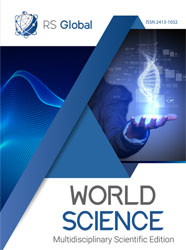LONG-TERM TEAM DENTAL REHABILITATION OF A YOUNG PATIENT WITH ECTODERMAL DYSPLASIA
Abstract
Today, one of the important issues in dentistry is the treatment of primary adentia, which has its own characteristics, taking into account the age of the patient, the need for orthodontic preparation for prosthetics, the design of the prosthesis. Primary adentia brings not only quantitative changes in the teeth, but also creates conditions for functional and morphological disorders of speech, breathing, chewing, leads to violations of the development of facial skeleton and causes underdevelopment of the jaws, which reduces the quality of life of the patient. Primary adentia with multiple missing teeth is a genetically determined condition and very often has a hereditary character in the form of hypohidrotic and hydrotic dysplasia. We present to your attention a description of the complex work of dentists on the completed case of a patient with a diagnosis of hypohidrotic ectodermal dysplasia (Christ-Siemens-Touraine syndrome). With multiple adentia, it is necessary to provide denture care as soon as possible, which requires engagement of dentists of various specialties in treatment and rehabilitation: orthodontists, orthopedists, therapists and maxillofacial surgeons
References
Al-Ani AH, Antoun JS, Thomson WM, Merriman TR, Farella M. Hypodontia: An Update on Its Etiology, Classification, and Clinical Management. Biomed Res Int. 2017;2017:9378325. doi:10.1155/2017/9378325
Nunn JH, Carter NE, Gillgrass TJ, et al. The interdisciplinary management of hypodontia: background and role of paediatric dentistry. Br Dent J. 2003;194(5):245-251. doi:10.1038/sj.bdj.4809925
Ye X, Attaie AB. Genetic Basis of Nonsyndromic and Syndromic Tooth Agenesis. J Pediatr Genet. 2016;5(4):198-208. doi:10.1055/s-0036-1592421
Jonsson L, Magnusson TE, Thordarson A, et al. Rare and Common Variants Conferring Risk of Tooth Agenesis. J Dent Res. 2018;97(5):515-522. doi:10.1177/0022034517750109
Wohlfart S, Meiller R, Hammersen J. et al. Natural history of X-linked hypohidrotic ectodermal dysplasia: a 5-year follow-up study. Orphanet J Rare Dis. 2020;15: 7. https://doi.org/10.1186/s13023-019-1288-x
Liu H, Su L, Liu H, Zheng J, Feng H, Liu Y, Yu M, Han D. Rare X-Linked Hypohidrotic Ectodermal Dysplasia in Females Associated with Ectodysplasin-A Variants and the X-Chromosome Inactivation Pattern. Diagnostics. 2022; 12:2300. https://doi.org/10.3390/diagnostics12102300
Deo K, Sharma YK, Shah B, et al. Improvement in the Quality of Life of a Patient of Ectodermal Dysplasia with Reconstructive Surgeries. J Cutan Aesthet Surg. 2019;12(4):244-247. doi:10.4103/JCAS.JCAS_17_19
Faezeh Atri, Sania Azizi, Sepehr Hatampou. Removable prosthetic treatment of an ectodermal dysplasia patient: A case report. Journal of Craniomaxillofacial Research. 2020;7(1):34-39. doi 10.18502/jcr.v7i1.4015
Views:
256
Downloads:
137
Copyright (c) 2024 Nataliya Emelyanova, Dmitry Emelyanov

This work is licensed under a Creative Commons Attribution 4.0 International License.
All articles are published in open-access and licensed under a Creative Commons Attribution 4.0 International License (CC BY 4.0). Hence, authors retain copyright to the content of the articles.
CC BY 4.0 License allows content to be copied, adapted, displayed, distributed, re-published or otherwise re-used for any purpose including for adaptation and commercial use provided the content is attributed.














